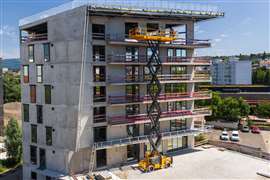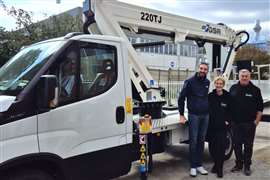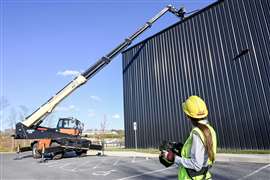Read this article in Français Deutsch Italiano Português Español
Three zero-emissions MEWPs pushing the boundaries of technology in 2025
05 September 2025
Three new platforms—from hydrogen-electric hybrids to a 56-metre all-electric truck mount—show how access equipment makers are redefining what zero-emissions technology can deliver on construction sites. Lewis Tyler reports.
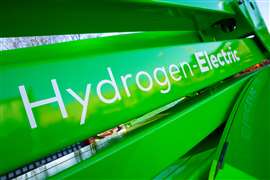 Niftylift’s hydrogen fuel cell-powered boom lift HR15 (Photo: Niftylift)
Niftylift’s hydrogen fuel cell-powered boom lift HR15 (Photo: Niftylift)
For decades, diesel engines have dominated the access platform sector, powering everything from small scissor lifts to 60-metre truck mounts. Today, however, that dominance is being steadily eroded. A new generation of zero-emissions machines is emerging, combining the operational power of their diesel predecessors with advances in electrification, telematics and hydrogen fuel cells.
While early prototypes often felt like experiments in green engineering, the latest wave of platforms represents commercial readiness.
Below, we examine three of the most technologically advanced machines now coming to market—each pointing to how access platforms could evolve over the next decade.
1. Niftylift HR17 H2E: hydrogen-electric hybrid
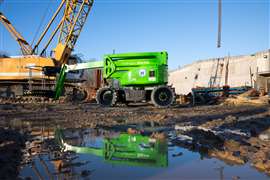 Niftylift’s hydrogen fuel cell-powered boom lift HR15 (Photo: Niftylift)
Niftylift’s hydrogen fuel cell-powered boom lift HR15 (Photo: Niftylift)
Hydrogen has long been touted as a solution for industries where batteries struggle to provide sufficient range or power. For access platforms, the key obstacle is runtime. Battery machines are well suited to short-duration tasks in controlled environments, but on large infrastructure sites or remote projects where charging is impractical, they can falter.
UK manufacturer Niftylift is addressing this challenge directly. Its HR17 H2E combines a fully electric drive system with an onboard hydrogen fuel cell, enabling extended operation without connection to the mains. The fuel cell is fed by a standard G20 hydrogen bottle, easily replaced on site, giving the platform the autonomy required for long shifts.
With a 17.2-metre working height, 9-metre outreach and 225kg platform capacity, the HR17 H2E delivers the performance expected of a mid-sized boom. Added features—non-marking tyres, 180° platform rotation, 360° turret slew, and telematics via Niftylink—demonstrate that the machine is not merely a sustainability experiment but a fully equipped work tool.
“This machine is a game-changer,” says Tom Hadden, Niftylift’s global technical sales manager. “It offers zero-emissions operation with only water vapour as a by-product. The ability to operate for extended periods without charging infrastructure sets it apart.”
Interest has been strong across northern Europe and the Middle East, where rental companies are under pressure to expand low-emission fleets. Yet the HR17 H2E also underscores a wider debate: while hydrogen solves runtime challenges, it requires a supply chain for production, storage and distribution that remains underdeveloped in many markets.
2. JLG EC450AJ: lithium-ion muscle
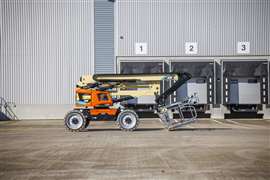 The compaxt new RT lift is powered by lithium batteries. (Image: JLG).
The compaxt new RT lift is powered by lithium batteries. (Image: JLG).
If hydrogen is the long-term wildcard, lithium-ion batteries remain the workhorse of electrification. Advances in chemistry, energy density and charging flexibility mean that battery-powered platforms are increasingly capable of replacing diesel across mainstream applications.
The JLG EC450AJ Compact, launched in Europe and built in Italy, is a case in point. At just 2 metres wide with zero tail swing, the articulated boom is designed for tight urban sites. It comes with a 10kWh lithium iron phosphate battery pack, with an optional 20kWh upgrade for longer runtimes. Charging can be done via a standard 230V single-phase outlet or a faster 400V three-phase supply. Integrated battery heaters ensure functionality in colder climates.
Where the machine distinguishes itself is in performance. It features 4WD electric drive, an oscillating axle, and transport slope handling of up to 45%—capabilities once associated exclusively with diesel rough-terrain machines. The platform capacity is 250kg, sufficient for two operators and tools, while operator-friendly design touches include a three-entry platform, enhanced safety systems, and ClearSky SmartFleet telematics for fleet management.
By delivering both rough-terrain capability and zero emissions, the EC450AJ demonstrates that lithium-ion is no longer confined to small indoor scissors. For rental companies, it offers a scalable option that aligns with customer demand for low-carbon equipment without requiring investment in hydrogen infrastructure.
3. Bronto Skylift S56XR: an all-electric giant
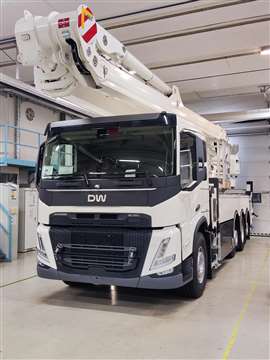 Bronto Skylift’s S56XR full electric lift will be delivered to Rohr. (Photo: Bronto Skylift).
Bronto Skylift’s S56XR full electric lift will be delivered to Rohr. (Photo: Bronto Skylift).
The most dramatic technological leap, however, is occurring at the very top end of the market. At Bauma, the industry’s largest trade fair, Bronto Skylift unveiled the S56XR, the world’s first all-electric truck-mounted access platform with a working height of 56 metres.
Developed with Rohr and Volvo Group subsidiary Designwerk Technologies AG, the S56XR is mounted on a purpose-built electric truck chassis powered by a 500kWh battery pack. The result is a machine capable of a full day’s operation on a single charge, including both driving and aerial work.
The specifications are formidable: a horizontal outreach of 40 metres, cage capacity between 600 and 700kg, and an extendable cage up to 3.7 metres wide. Real-time battery monitoring and an adapted electric power take-off system help optimise energy consumption, a critical factor at this scale.
For urban applications such as utility maintenance, telecoms installation or façade work, the S56XR’s significance is clear. Large truck mounts are often deployed in dense city centres where emissions and noise restrictions are tightening. An all-electric model eliminates tailpipe emissions and reduces noise, potentially easing permitting processes and expanding the range of viable projects.
STAY CONNECTED



Receive the information you need when you need it through our world-leading magazines, newsletters and daily briefings.
CONNECT WITH THE TEAM










